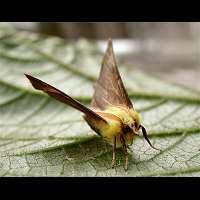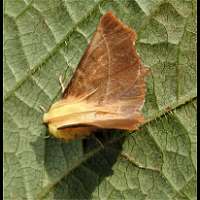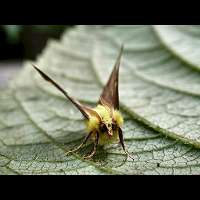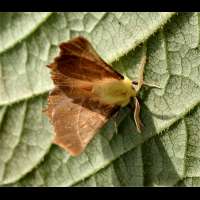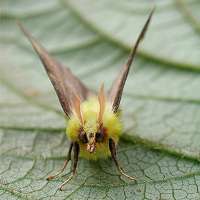Canary-shouldered Thorn (Ennomos alniaria)
The Canary-shouldered Thorn is just one of the many yellow Thorns. Luckily it can be identified easily by the extremely hairy, brightly yellow body. The ground colour of the wings is very variable though. Most animals have more brightly coloured yellow wings. The animal in our picture is unusually dark. The wings are kept half raised, characteristic for most of the Thorns. The Canary-shouldered Thorn reaches a wingspan of some 38 to 42 mm and is among the smaller Thorns.
The larva of the Canary-shouldered Thorn is dark brown with blackish brown markings. It has two small bumps on the back and one relatively big one on the 5th segment. It has another small bump just in front of the tail. Like other larvae of Thorns it looks like a twig very much indeed. Compared to other moths of this size, the caterpillar is very long (up to 5 cm), but very thin as well. And towards the head it is getting even slimmer. The head itself is brown. The eggs are being laid in autumn and they overwinter as such, to hatch only in May of next year. The larvae feed at night and stay motionless during daytime, hoping not to be noticed due to their camouflage. In July they drop to the ground to pupate. Pupation happens in a cocon among leaflitter or under mosses. The caterpillars can be found on a number of trees, including birch, alder, sallow, lime and elm.
The Canary-shouldered Thorn has only one generation a year, on the wing from July to the beginning of October. It only flies during the hours of darkness. Comes to light in reasonable numbers. And that's our luck, for otherwise it is rarely seen at all. A common species all over the British Isles, preferring woodlands, parks, large gardens and sandhills. In most other parts of Europe a very common species too.
The Canary-shouldered Thorn is just one of the many yellow Thorns. Luckily it can be identified easily by the extremely hairy, brightly yellow body. The ground colour of the wings is very variable though. Most animals have more brightly coloured yellow wings. The animal in our picture is unusually dark. The wings are kept half raised, characteristic for most of the Thorns. The Canary-shouldered Thorn reaches a wingspan of some 38 to 42 mm and is among the smaller Thorns.
The larva of the Canary-shouldered Thorn is dark brown with blackish brown markings. It has two small bumps on the back and one relatively big one on the 5th segment. It has another small bump just in front of the tail. Like other larvae of Thorns it looks like a twig very much indeed. Compared to other moths of this size, the caterpillar is very long (up to 5 cm), but very thin as well. And towards the head it is getting even slimmer. The head itself is brown. The eggs are being laid in autumn and they overwinter as such, to hatch only in May of next year. The larvae feed at night and stay motionless during daytime, hoping not to be noticed due to their camouflage. In July they drop to the ground to pupate. Pupation happens in a cocon among leaflitter or under mosses. The caterpillars can be found on a number of trees, including birch, alder, sallow, lime and elm.
The Canary-shouldered Thorn has only one generation a year, on the wing from July to the beginning of October. It only flies during the hours of darkness. Comes to light in reasonable numbers. And that's our luck, for otherwise it is rarely seen at all. A common species all over the British Isles, preferring woodlands, parks, large gardens and sandhills. In most other parts of Europe a very common species too.

